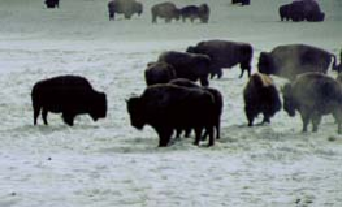Travel Reference
In-Depth Information
Bison herd in winter
The calm-looking bison can be every bit as cantankerous as a farmer's bull and can sprint
faster than any Olympic runner.
The bison is the most dangerous animal in the park;
many
people have been injured. Bison herds graze along the Madison and Firehole Rivers and in the
Hayden and Lamar Valleys.
The Brucellosis Problem
The late 1990s saw a difficult problem arise between the agencies responsible for protecting
bison and the ranchers who graze herds of cattle on private and public property all around
Yellowstone. The basic problem is brucellosis, a disease that can cause a pregnant cow to
abort her calf but does not cause abortion in bison. Montana ranchers fear the disease
could be transmitted to their certified brucellosis-free cattle when infected bison migrate
to winter feeding grounds outside the park.
Following the signing of an interagency agreement in 2000, the National Park Service
and the Montana Department of Livestock sometimes haze bison back into the park from
the north and west in winter; some are allowed to migrate north, some quarantined, and
some relocated to Indian reservations. Healthy calves are vaccinated, and winter bison
hunts are held. These measures have been holding the Yellowstone herd to about 4,300.
Factors complicating the story include the strong historical possibility that brucellosis was
originally introduced into Yellowstone by infected cows brought in to supply milk for the
early hotels and the fact that elk also carry brucellosis.
B
EARS
Grizzly bears were probably more common here than black bears in the nineteenth century.
Recent estimates put the number of grizzlies in the Greater Yellowstone Ecosystem at about
six hundred (with at least half of those in the park itself); black bears are not as closely
watched, but now their number is similar or a little larger.

